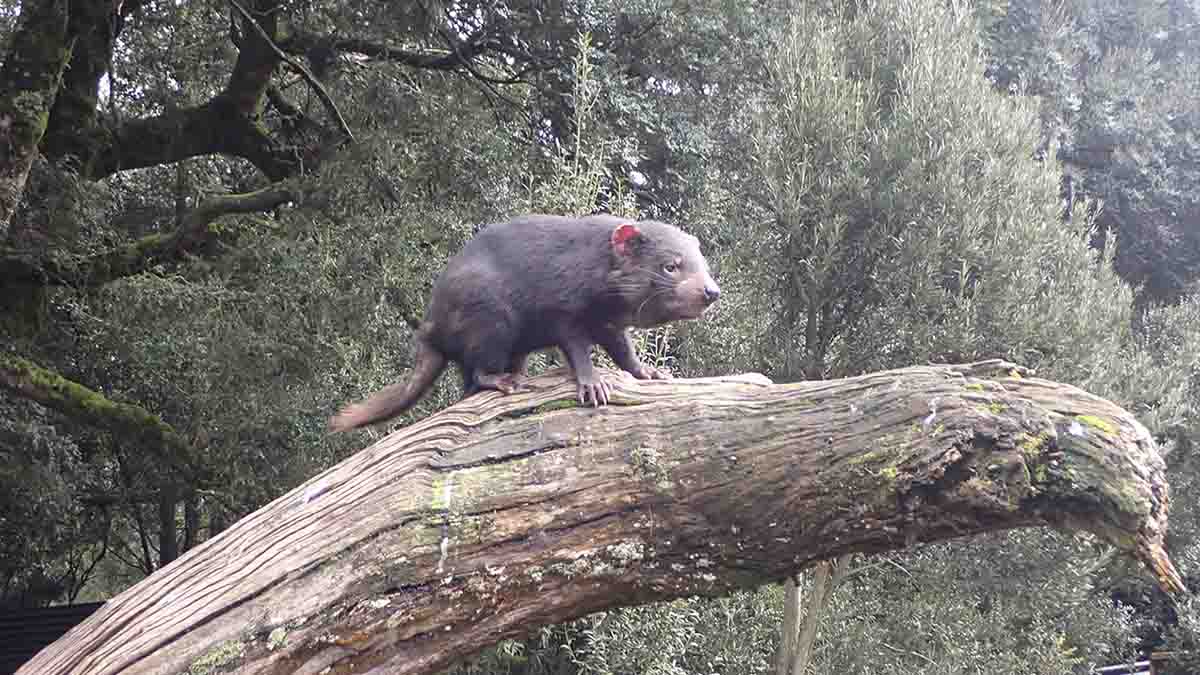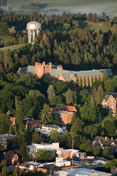Predator Ecosystem Impacts
January 22, 2025
A University of Idaho study of Tasmanian devils concludes the loss of predators and scavengers from an ecosystem can impair plant and soil health, while potentially elevating greenhouse gas emissions.
Assistant Professor Laurel Lynch and Associate Professor Michael Strickland, both with the Department of Soil and Water Systems, and Professor Tara Hudiburg, with the Department of Forest, Rangeland and Fire Sciences, based their findings on a multi-year study on the ecological ripple effects of a transmissible cancer that has decimated the devil population.
Devils are the largest carnivorous marsupial species, found only on the island of Tasmania. In the late 1990s, devil numbers began to plumet following the confirmation of devil facial tumor disease (DFTD), spread by saliva when the small-dog-sized predators fight one another. About 70% of devils on the island have already perished, though scientists suspect the devil population is beginning to stabilize.
The U of I researchers are finishing the final year of a four-year, $677,575 National Science Foundation grant involving tree-core sampling and an analysis of herbivore carcass decomposition on the soil microbiome in Tasmania, as well as a laboratory experiment on campus.
“Tasmania offers a unique study system where you have a natural population decline of the top predator on the island and you can leverage that to ask these foundational questions in ecology,” Lynch said. “Being able to link changes in animal populations with forest ecology gives us a better understanding of how carbon is cycling not just in Tasmania, but in all systems worldwide.”
The decline of the island’s top predator due to DFTD has disturbed the balance of a previously efficient ecosystem. Mid-tier predators and scavengers that would otherwise be controlled by devils, including quolls, feral cats and possums, have taken over the island and are overfeeding on native marsupials, such as pademelons. Reductions in herbivore numbers have led to vegetation overgrowth. Diseases can also become more prevalent when population balances are skewed.
The researchers confirmed devils also play an important role in redistributing nutrients from animal carcasses by eating them and defecating over a broad area.
“If you knock one of those organisms out, you have this imbalanced, inefficient system,” Lynch said. “Preserving biodiversity is really important for preserving ecosystem function.”
The study entailed placing pademelon carcasses inside of cages with bars narrow enough to restrict devil access but wide enough for other scavengers to pass through in parts of the island where devil populations range from sparse to nearly normal. Additional carcasses were left unprotected near cages to allow access by all the island’s scavengers.
Devils are among the few species that consume every part of an animal, including the bone. Where they were present, unprotected carcasses essentially vanished overnight. Hudiburg and Lynch have taken tree core samples from throughout the island to study calcium levels in tree rings as a biomarker, helping them assess how nutrient distribution is affected when devil populations decline.
Secondary predators and scavengers consumed only portions of carcasses that were caged or placed in areas where few devils were present. The remainders of those carcasses were slowly broken down by invertebrates and microorganisms, and the researchers believe the leakage of nutrients directly below carcasses fueled the growth of fast-growing, but less efficient microorganisms.
Without devils to evenly distribute carcass nutrients through their scat, even the ability of soil to store carbon may be thrown out of kilter. In a Moscow laboratory, the researchers will conduct an experiment this spring evaluating the efficiency of microbial communities, comparing how they respond to nutrients from plant litter, carcasses and scat.
“The hypothesis is if you grow microorganisms really quickly, you are growing less efficiently,” Lynch said. “You have high metabolic costs, with a lot of carbon being recycled back into the atmosphere as carbon dioxide. It’s a very leaky system.”
Predator species are especially sensitive as human development continues encroaching upon wild lands, making it timely to understand the important role they play in a broader ecosystem.
“We tend to ignore how the presence of scavengers or predators within an ecosystem can shift or alter the trajectory of it,” Strickland said. “We are losing these organisms at a higher rate than any other organisms on the planet. They end up getting in direct conflict with humans, who are driving their numbers down. We are losing them at such a high rate that it’s hard to understand what their roles are, but in a place like Tasmania we can get at those roles, and we can understand the value of these organisms in the ecosystem context.”

About the University of Idaho
The University of Idaho, home of the Vandals, is Idaho’s land-grant, national research university. From its residential campus in Moscow, U of I serves the state of Idaho through educational centers in Boise, Coeur d’Alene and Idaho Falls, nine research and Extension centers, plus Extension offices in 42 counties. Home to more than 12,000 students statewide, U of I is a leader in student-centered learning and excels at interdisciplinary research, service to businesses and communities, and in advancing diversity, citizenship and global outreach. U of I competes in the Big Sky and Western Athletic conferences. Learn more at uidaho.edu.






